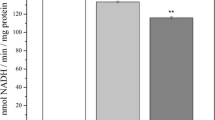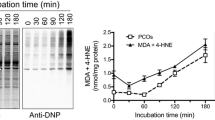Abstract
Oxidants have been shown to play a major role in ageing and ageing-related neurodegenerative diseases. In the present study, we investigated the effect of ageing on oxidative damage to lipids and proteins in brain homogenate, mitochondria and synaptosomes of adult (6-month-old), old (15-month-old), and senescent (26-month-old) Wistar rats. There was a significant increase in thiobarbituric acid-reactive substances and conjugated dienes in homogenates, which indicate increased lipid peroxidation (LPO). Oxidative modifications of homogenate proteins were demonstrated by a loss of sulfhydryl content, accumulation of dityrosines and formation of protein conjugates with LPO-end products. Increase in protein conjugates with LPO-end products and a decrease in SH groups were observed also in mitochondria and synaptosomes, but dityrosine content was elevated only in synaptosomes. Protein surface hydrophobicity, measured by fluorescent probe 1-anilino-8-naphthalenesulfonate (ANS), was increased only in homogenate. These results suggest that besides mitochondria and synaptosomes other cellular compartments are oxidatively modified during brain ageing.






Similar content being viewed by others
References
Pérez-Severiano F, Santamaría A, Pedraza-Chaverri J et al (2004) Increased formation of reactive oxygen species, but no changes in glutathione peroxidase activity, in striata of mice transgenic for the Huntington’s disease mutation. Neurochem Res 29:729–733
Linnane AW, Marzuki S, Ozawa T et al (1989) Mitochondrial DNA mutations as an important contributor to ageing and degenerative diseases. Lancent 1:642–645
Beckman KB, Ames BN (1998) The free radical theory of aging matures. Physiol Rev 78:547–581
Chatgilialoglu C, O′Neill P (2001) Free radicals associated with DNA damage. Exp Gerontol 36:1459–1471
Ding Q, Markesbery WR, Cecarini V et al (2006) Decreased RNA, and increased RNA oxidation, in ribosomes from early Alzheimer’s disease. Neurochem Res 31:705–710
Halliwell B, Gutteridge JMC (1999) Free radicals in biology and medicine. Oxford University Press, New York, pp 246–350
Stadtman ER (1992) Protein oxidation and aging. Science 257:1220–1224
Stadtman ER, Levine RL (2000) Protein oxidation. Ann N Y Acad Sci 899:191–208
Diaz-Ruiz A, Vergara P, Perez-Severiano F et al (2007) Acute alterations of glutamate, glutamine, GABA, and other amino acids after spinal cord contusion in rats. Neurochem Res 32:57–63
Stadtman ER, Berlett BS (1997) Reactive oxygen-mediated protein oxidation in aging and disease. Chem Res Toxicol 10:485–494
Fu S, Davies J, Dean RT (1998). Molecular aspects of free radical damage to proteins. In: Aruoma OI, Halliwell B (eds) Molecular biology of free radicals in human diseases. OICA International, Santa Lucia, London pp 29–56
Stadtman ER, Levine RL (2003) Free radical-mediated oxidation of free amino acids and amino acid residues in proteins. Amino Acids 25:207–218
Shacter E (2000) Protein oxidative damage. Methods Enzymol 319:428–436
Davies KJA (1987) Protein damage and degeneration by oxygen radicals. J Biol Chem 262:9895–9901
Stadtman ER (1993) Oxidation of free amino acids and amino acids residues in proteins by radiolysis and by metal-catalyzed reaction. Annu Rev Biochem 62:797–821
Head E, Liu J, Hagen TM et al (2002) Oxidative damage increases with age in a canine model of human brain aging. J Neurochem 82:375–381
Cakatay U, Telci A, Kayali R et al (2001) Relation of oxidative protein damage and nitrotyrosine levels in the aging rat brain. Exp Gerontol 36:221–229
Davies SM, Poljak A, Duncan MW et al (2001) Measurements of protein carbonyls, ortho- and meta-tyrosine and oxidative phosphorylation complex activity in mitochondria from young and old rats. Free Radic Biol Med 31:181–190
Leeuwenburgh C, Rasmussen JE, Hsu FF et al (1997) Mass spectrometric quantification of markers for protein oxidation by tyrosyl radical, copper, and hydroxyl radical in low density lipoprotein isolated from human atherosclerotic plaques. J Biol Chem 272:3520–3526
Tian L, Cai Q, Wei H (1998) Alterations of antioxidant enzymes and oxidative damage to macromolecules in different organs of rats during aging. Free Radical Biol Med 24:1477–1484
Abd El Mohsen MM, Iravani MM, Spencer JP et al (2005) Age-associated changes in protein oxidation and proteasome activities in rat brain: modulation by antioxidants. Biochem Biophys Res Commun 21:386–391
Dodd PR, Hardy JA, Oakley AE et al (1981) A rapid method for preparing synaptosomes: comparison with alternative procedures. Brain Res 226:107–118
Lowry OH, Rosebrough NJ, Farr AL et al (1951) Protein measurement with the Folin phenol reagent. J Biol Chem 193:265–275
Dousset N, Ferretti G, Taus M et al (1994) Fluorescence analysis of lipoprotein peroxidation. Methods Enzymol 233:459–469
Giulivi C, Davies KJA (1994) Dityrosine: a marker for oxidatively modified proteins and selective proteolysis. Methods Enzymol 233:363–371
Hu ML (1994) Measurement of protein thiol groups and glutathione in plasma. Methods Enzymol 233:380–385
Braughler JM, Duncan LA, Chase RL (1986) The involvment of iron in lipid peroxidation. J Biol Chem 261:10282–10289
Klein RA (1970) The detection of oxidation in liposome preparations. Biochim Biophys Acta 210:483–486
Das DK (1994) Cellular, biochemical, and molecular aspects of reperfusion injury. Ann N Y Acad Sci 723:118–124
Nawarro A, Boveris A (2004) Rat brain and liver mitochondria develop oxidative stress and lose enzymatic activities on aging. Am J Physiol 287:R1244-R1249
Cini M, Moretti A (1995) Studies on lipid peroxidation and protein oxidation in the aging brain. Neurobiol Aging 16:53–57
Keller JN, Mark RJ, Bruce AJ et al (1997) 4-hydroxynonenal, an aldehydic product of membrane lipid peroxidation, impairs glutamate transport and mitochondrial function in synaptosomes. Neuroscience 80:685–696
Davies MJ, Fu S, Wang H et al (1999) Stable markers of oxidant damage to proteins and their application in the study of human disease. Free Radic Biol Med 27:1151–1163
Leeuwenburgh C, Wagner P, Holloszy JO et al (1997) Caloric restriction attenuates dityrosine cross-linking of cardiac and skeletal muscle proteins in aging mice. Arch Biochem Biophys 346:74–80
Chao CC, Ma YS, Stadtman ER (1997) Modification of protein surface hydrophobicity and methionine oxidation by oxidative systems. Proc Natl Acad Sci U S A 94:2969–2977
Acknowledgments
This work was partially supported by grants VEGA 1/2263/05 and 3380/06, MVTS 39 and APVT-51-027404 from the Ministry of Education and Science of the Slovak Republic. The authors thank to Prof. B. Hamprecht and Dr. R. Murin for their comments and critically reading the manuscript.
Author information
Authors and Affiliations
Corresponding author
Rights and permissions
About this article
Cite this article
Babusikova, E., Hatok, J., Dobrota, D. et al. Age-related Oxidative Modifications of Proteins and Lipids in Rat Brain. Neurochem Res 32, 1351–1356 (2007). https://doi.org/10.1007/s11064-007-9314-0
Received:
Accepted:
Published:
Issue Date:
DOI: https://doi.org/10.1007/s11064-007-9314-0




